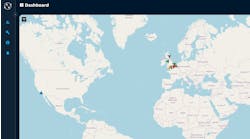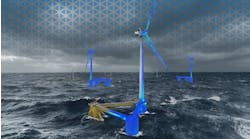Frank Hartley
Houston
Tri-lateral level 4 is firm's 275th multilateral junction
A TAML (technology advancement for multilaterals) level 4 tri-lateral was successfully completed in eastern Venezuela by Sperry-Sun Drilling Services, its 275th multilateral junction. In response to the need to improve exploitation in the Venezuelan field, use of multilateral well technology, particularly the RMLS' (retrievable multilateral system) was implemented.
Multilateral drilling and completions systems have consistently been identified as a means of increasing production from the heavy oil field by facilitating the placement of two or more horizontal wellbores into the A, B, and C producing formations from one surface location. To date, 24 junctions have been completed on 13 of the operator's wells (nine tri-lateral and four dual-lateral) using this system.
Two pre-milled windows were installed in the primary 9 5/8-in. casing string, allowing two 8 1/2-in. laterals to be drilled in addition to the mainbore. Junction stability was achieved with the casing and cementing of both the mainbore and the laterals, thereby minimizing sand influx at the junction and the risk of a lateral loss. The level 4 junction should provide the best quality multilateral, remaining fully accessible and serviceable for the life of the well. Participation in the operator's development project commenced in early 2000, with a commitment for five 9 5/8-in. windows.
New approach to reservoir sampling and analysis
A sampling device, the EXothermal Sampler and GOLD (global onsite laboratory data) system by Expro International Group PLC, enables onsite measurement of fluid composition and PVT (pressure-volume-temperature) properties, without subjecting the fluid to potentially damaging thermodynamic changes incurred when products are brought to surface. Among the advantages of being able to analyze a sample in its native state is an improved level of understanding about reservoir behavior that will, in turn, improve development decisions.
Irreversible modifications to the fluid properties introduced by changing temperatures and pressures during the sampling and retrieval process can lead to uncertainties about current sampling and analysis results. These problems, in conjunction with delays in shipping samples to an appropriate laboratory and the lengthy processes involved in established sample restoration and analysis methods, can contribute to poor development decisions, compromised by an incomplete understanding of the reservoir fluid behavior.
The fluid analysis-sampling tool takes samples from the reservoir and retrieves them to the surface while maintaining bottomhole conditions, including temperature and pressure. The device can be run on slickline or e-line. This tool withstands bottom hole temperatures up to 175 degrees psi C and pressures up to 20,000 psi.
The device is accompanied by a portable PVT and compositional analysis system that can be used at the well site and which provides data to the same standards as conventional PVT laboratories. The system has been developed with remote areas in mind, where sample transportation can add significant cost and time penalties. By minimizing the effect of fluid alteration, the system contributes to improved results in fluid analysis, specifically:
- Accurate asphaltene and wax analyses from PVT samples and formation water samples with scale deposition problems have been proven to be affected by temperature variation caused during sample retrieval
- No gas breakout due to pressure reduction
- Accurate scale deposition analysis
- No retrograde liquid drop due to pressure and/or temperature reduction
- Accurate hydrate formation analysis
- Accurate wax crystallization modeling.
The system uses specially adapted chromatographs to perform laboratory standard compositional measurements to C30+ on both liquid and gas samples, allowing comprehensive characterization of the reservoir fluid. Further modules can be added to order to analyze key PVT properties at reservoir conditions, including saturation pressure, single phase fluid compressibility, density, viscosity, and gas-oil ratios. Additional modules permit measurement of trace components in the oil; flow assurance properties and water chemistry can also be added. The system has been developed around the following specific requirements:
- Fully air transportable
- Instrumentation is sufficiently rugged to permit operation in an offshore environment
- All analysis and measurements can be performed without the use of mercury
- Ability to measure sufficient PVT property measurements in order to construct a robust equation of state model
- Gas and liquid compositional analysis to C30+, with all major isomers up to C10 identified and quantified. Accuracy and precision equivalent to conventional laboratories.
- Flow assurance measurement (wax and asphaltene) capability
- Water analysis capability.
Expandable sand screen system
A first-of-its kind expandable sand screen (ESS) system for Sabah Shell's South Furious Well#26 in East Malaysia was developed and successfully installed by Weatherford International Completion Systems Division. System development, along with combining several products specifically for this application, produced a multi-zone cased hole sand control with zonal isolation capability. The system included ESS technology (a sand control system capable of considerable expansion in the wellbore), large bore EXP liner hanger, an expandable completion liner (ECL), an expandable isolation sleeve (EIS), and an isolation packer HRH.
A 634-ft-long sand face completion consisting of a 4-in., 150 micron ESS, 4-inch EIS, 4-in. ECL, 4-in. ECL-R, and 7 in. by 5 1/2 in. EXP packer was deployed into the well and then expanded. Zonal isolation for the sand bodies was provided by the EIS sections placed above and below the expandable screens. Additionally, flow selectivity from each zone was achieved by setting straddling tubing and sliding sleeves between HRH isolation packers, which later were set inside the rubber-coated ECL-R.
Drill bits change hard rock drilling while saving rig time
While conventional impregnated bits typically employ a slow grinding action that fails in some formations, Security DBS claims its new Millennium Series incorporates a synthetic diamond technology to micro-shear the formation. This improves drilling optimization and provides faster rates of penetration in the full range of hard rock drilling.
By incorporating this diamond back-up design into proprietary whirl-resistant bit designs, the bit series technology pushes PDC (polychrystalline diamond compact) bits into harder rock, from the top end of IADC code five series roller cone equivalent into the six series drillable rock.
Diamond segments and disks are produced at a lower temperature, resulting in self-sharpening synthetic diamonds that are able to drill the tougher formations. A double phase impregnation process produces a self-sharpening cutting edge, as well as providing erosion and abrasive wear protection. Diamond impregnated cylinders trail the PDC cutters in a seamless direct extension. Thus, when abrasive rock is encountered, PDC cutters wear down slightly, and the diamond cylinders effect a micro-shearing action. As softer rock is re-entered, the PDC cutters take over again until the next hard layer is encountered.
Also, diamond impregnation technology allows for the fine-tuning of bit designs. This concept empowers an application design engineer to provide product selection, application, design, and evaluation expertise at a local drilling site or throughout the region. The bit can be customized for a variety of applications by varying the length of the back-up row, the volume of diamond, and the range of matrix material that holds the diamond. Such flexibility enables PDC technology to move into what traditionally has been harder roller cone levels of hardness.
The mixed cutter bit designs have been proven in South America, the Gulf of Mexico, and in the North Sea, where in one well, a single FM2000i bit replaced five roller cone bits and trip time normally required to drill out the hard layers.


